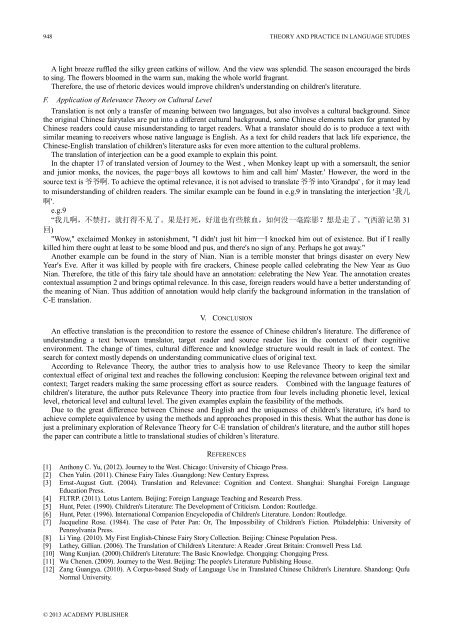Theory and Practice in Language Studies Contents - Academy ...
Theory and Practice in Language Studies Contents - Academy ...
Theory and Practice in Language Studies Contents - Academy ...
You also want an ePaper? Increase the reach of your titles
YUMPU automatically turns print PDFs into web optimized ePapers that Google loves.
948 THEORY AND PRACTICE IN LANGUAGE STUDIESA light breeze ruffled the silky green catk<strong>in</strong>s of willow. And the view was splendid. The season encouraged the birdsto s<strong>in</strong>g. The flowers bloomed <strong>in</strong> the warm sun, mak<strong>in</strong>g the whole world fragrant.Therefore, the use of rhetoric devices would improve children's underst<strong>and</strong><strong>in</strong>g on children's literature.F. Application of Relevance <strong>Theory</strong> on Cultural LevelTranslation is not only a transfer of mean<strong>in</strong>g between two languages, but also <strong>in</strong>volves a cultural background. S<strong>in</strong>cethe orig<strong>in</strong>al Ch<strong>in</strong>ese fairytales are put <strong>in</strong>to a different cultural background, some Ch<strong>in</strong>ese elements taken for granted byCh<strong>in</strong>ese readers could cause misunderst<strong>and</strong><strong>in</strong>g to target readers. What a translator should do is to produce a text withsimilar mean<strong>in</strong>g to receivers whose native language is English. As a text for child readers that lack life experience, theCh<strong>in</strong>ese-English translation of children's literature asks for even more attention to the cultural problems.The translation of <strong>in</strong>terjection can be a good example to expla<strong>in</strong> this po<strong>in</strong>t.In the chapter 17 of translated version of Journey to the West , when Monkey leapt up with a somersault, the senior<strong>and</strong> junior monks, the novices, the page−boys all kowtows to him <strong>and</strong> call him' Master.' However, the word <strong>in</strong> thesource text is 爷 爷 啊 . To achieve the optimal relevance, it is not advised to translate 爷 爷 <strong>in</strong>to 'Gr<strong>and</strong>pa' , for it may leadto misunderst<strong>and</strong><strong>in</strong>g of children readers. The similar example can be found <strong>in</strong> e.g.9 <strong>in</strong> translat<strong>in</strong>g the <strong>in</strong>terjection ' 我 儿啊 '.e.g.9“ 我 儿 啊 , 不 禁 打 , 就 打 得 不 见 了 。 果 是 打 死 , 好 道 也 有 些 脓 血 , 如 何 没 一 毫 踪 影 ? 想 是 走 了 。”( 西 游 记 第 31回 )"Wow," exclaimed Monkey <strong>in</strong> astonishment, "I didn't just hit him−−I knocked him out of existence. But if I reallykilled him there ought at least to be some blood <strong>and</strong> pus, <strong>and</strong> there's no sign of any. Perhaps he got away."Another example can be found <strong>in</strong> the story of Nian. Nian is a terrible monster that br<strong>in</strong>gs disaster on every NewYear's Eve. After it was killed by people with fire crackers, Ch<strong>in</strong>ese people called celebrat<strong>in</strong>g the New Year as GuoNian. Therefore, the title of this fairy tale should have an annotation: celebrat<strong>in</strong>g the New Year. The annotation createscontextual assumption 2 <strong>and</strong> br<strong>in</strong>gs optimal relevance. In this case, foreign readers would have a better underst<strong>and</strong><strong>in</strong>g ofthe mean<strong>in</strong>g of Nian. Thus addition of annotation would help clarify the background <strong>in</strong>formation <strong>in</strong> the translation ofC-E translation.V. CONCLUSIONAn effective translation is the precondition to restore the essence of Ch<strong>in</strong>ese children's literature. The difference ofunderst<strong>and</strong><strong>in</strong>g a text between translator, target reader <strong>and</strong> source reader lies <strong>in</strong> the context of their cognitiveenvironment. The change of times, cultural difference <strong>and</strong> knowledge structure would result <strong>in</strong> lack of context. Thesearch for context mostly depends on underst<strong>and</strong><strong>in</strong>g communicative clues of orig<strong>in</strong>al text.Accord<strong>in</strong>g to Relevance <strong>Theory</strong>, the author tries to analysis how to use Relevance <strong>Theory</strong> to keep the similarcontextual effect of orig<strong>in</strong>al text <strong>and</strong> reaches the follow<strong>in</strong>g conclusion: Keep<strong>in</strong>g the relevance between orig<strong>in</strong>al text <strong>and</strong>context; Target readers mak<strong>in</strong>g the same process<strong>in</strong>g effort as source readers. Comb<strong>in</strong>ed with the language features ofchildren's literature, the author puts Relevance <strong>Theory</strong> <strong>in</strong>to practice from four levels <strong>in</strong>clud<strong>in</strong>g phonetic level, lexicallevel, rhetorical level <strong>and</strong> cultural level. The given examples expla<strong>in</strong> the feasibility of the methods.Due to the great difference between Ch<strong>in</strong>ese <strong>and</strong> English <strong>and</strong> the uniqueness of children's literature, it's hard toachieve complete equivalence by us<strong>in</strong>g the methods <strong>and</strong> approaches proposed <strong>in</strong> this thesis. What the author has done isjust a prelim<strong>in</strong>ary exploration of Relevance <strong>Theory</strong> for C-E translation of children's literature, <strong>and</strong> the author still hopesthe paper can contribute a little to translational studies of children‟s literature.REFERENCES[1] Anthony C. Yu, (2012). Journey to the West. Chicago: University of Chicago Press.[2] Chen Yul<strong>in</strong>. (2011). Ch<strong>in</strong>ese Fairy Tales .Guangdong: New Century Express.[3] Ernst-August Gutt. (2004). Translation <strong>and</strong> Relevance: Cognition <strong>and</strong> Context. Shanghai: Shanghai Foreign <strong>Language</strong>Education Press.[4] FLTRP. (2011). Lotus Lantern. Beij<strong>in</strong>g: Foreign <strong>Language</strong> Teach<strong>in</strong>g <strong>and</strong> Research Press.[5] Hunt, Peter. (1990). Children's Literature: The Development of Criticism. London: Routledge.[6] Hunt, Peter. (1996). International Companion Encyclopedia of Children's Literature. London: Routledge.[7] Jacquel<strong>in</strong>e Rose. (1984). The case of Peter Pan: Or, The Impossibility of Children's Fiction. Philadelphia: University ofPennsylvania Press.[8] Li Y<strong>in</strong>g. (2010). My First English-Ch<strong>in</strong>ese Fairy Story Collection. Beij<strong>in</strong>g: Ch<strong>in</strong>ese Population Press.[9] Lathey, Gillian. (2006). The Translation of Children's Literature: A Reader .Great Brita<strong>in</strong>: Cromwell Press Ltd.[10] Wang Kunjian. (2000).Children's Literature: The Basic Knowledge. Chongq<strong>in</strong>g: Chongq<strong>in</strong>g Press.[11] Wu Chenen. (2009). Journey to the West. Beij<strong>in</strong>g: The people's Literature Publish<strong>in</strong>g House.[12] Zang Guangya. (2010). A Corpus-based Study of <strong>Language</strong> Use <strong>in</strong> Translated Ch<strong>in</strong>ese Children's Literature. Sh<strong>and</strong>ong: QufuNormal University.© 2013 ACADEMY PUBLISHER
















